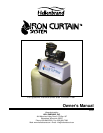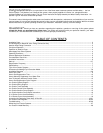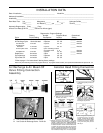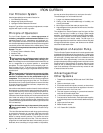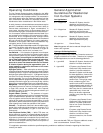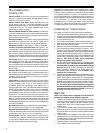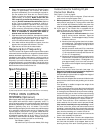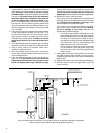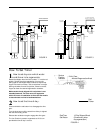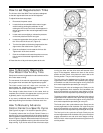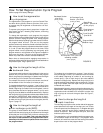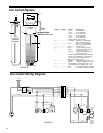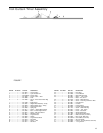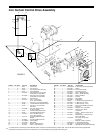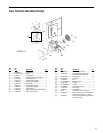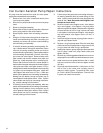
4
IRON CURTAIN
the way to solve this problem is to use layers of media.”
The advantages of a multi-media bed are:
1. Longer runs between backwash times.
2. Caking of the bed and breakthrough of turbidity are
virtually eliminated.
3. Much higher service flow rates per square foot.
4. Higher degree of clarity because of the heavier, finer filter
media in the bottom.
The standard Iron Curtain System uses five layers of filter
media. The top layer is made up of large, lighter weight
particles. The second layer contains a slightly heavier media.
The third layer contains a much heavier media.The fourth
layer contains an even heavier media. The fifth layer is a
special support bed to retain filter media so it does not pass
through the distribution system, and allows an even distrib-
uted flow of backwash water.
Operation of Aeration Pump
The Iron Curtain System introduces air into the aeration tank
and bleeds off the old head of air automatically. Following the
backwash cycle, both the air recharge valve and the air bleed
off valve open, allowing water and/or air to bleed out of the
aeration tank. After approximately 4 minutes, the aeration
pump automatically starts pumping a fresh head of air into the
aeration tank for approximately 10 minutes. After the pump
shuts off, the air recharge and air bleed off valves remain
open for an additional 4 minutes to allow any excess air and/
or water to bleed off to drain.
Advantages Over
Other Systems
1. Tested and validated by WQA under their S-200 Stan-
dard.
2. Uses no chemicals or salt.
3. Eliminates need for air injectors, venturis, or micronizers.
4. No floats or air volume controls to regulate air volume in
aeration tank which “foul” from iron.
5. Two-tank system consisting of a pressurized aeration
tank and multi-media depth filter.
6. 110V aeration pump to recharge aeration tank.
7. Can be used on shared wells, municipal water supplies,
or with buried pressure tanks without additional equip-
ment.
8. Higher service flow rates.
9. Better filtration results.
10. U.S. Patent #B1 5,096,596
Iron Filtration System
Aeration/precipitation/multi-media filtration for:
1. Iron Reduction/Removal
2. Manganese Reduction/Removal
3. Hydrogen Sulfide Reduction/Removal
A special Type A filter also provides pH adjustment on water
supplies with a pH from 6.0 or greater.
Principle of Operation
The Iron Curtain System uses a three step process of
oxidation, precipitation, and mechanical filtration for the
reduction/removal of iron, manganese, and hydrogen sul-
fide. The process of how the Iron Curtain System does each
one of these separate procedures is the key to the successful
results this product has obtained in the market place. There
are three main components that make up the Iron Curtain
System. They are:
1. IC Control Center w/Aeration Pump
2. Aeration Tank
3. Multi-Media Depth Filter
1
The first step in any oxidizing process is to bring the
raw water into intimate contact with a strong oxi-
dant. This will begin to convert the dissolved element such as
iron or manganese to a physical particle or nonsoluble
precipitate. The least expensive environmentally-safe oxi-
dant is oxygen (0
2
)–air. To do this, the Iron Curtain System
makes the water spray through a regulated head of air in the
aeration tank.
2
The second step in this three step process of oxida-
tion - precipitation - filtration is to provide adequate
reaction or contact time for the precipitation to go to
completion. This allows time for the iron and/or manganese
particles to become large enough to filter out. The aeration
tank with the Iron Curtain System allows for several minutes
of contact time at the rated service flows, compared to only
seconds on other systems.
It should be noted that this reaction time will also be affected
by temperature; the warmer the water the faster the reaction.
This reaction time may also be affected by the presence of
organic material (such as tannins).
If tannins are present,
field tests have shown that they will not be removed and will
also hinder the ability of this system to effectively remove
iron, manganese, and/or hydrogen sulfide. Installation of this
system on water supplies with more than 0.5 ppm of tannins
will void warranty.
3
The third and final step is the removal of the precipi-
tates from the water. The WQA Water Filtration Study
Guide states:
“The ideal filter bed would be one with large grains at the top
to prevent the formation of a surface cake and to provide
large pores for course particles and small grains at the
bottom to entrap smaller particles. This allows the entire
depth of the bed to be used as a filter. This also allows for
longer filter runs and faster flow rates. Unfortunately, such an
ideal bed, when consisting of a single media is not possible,



